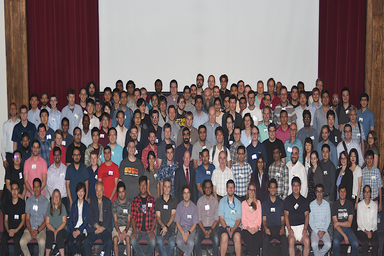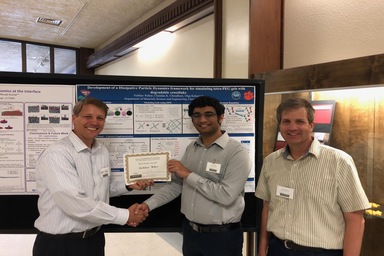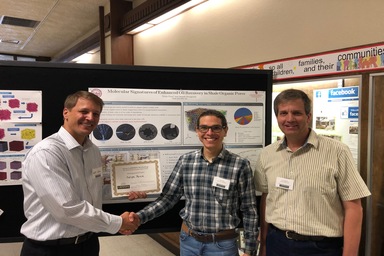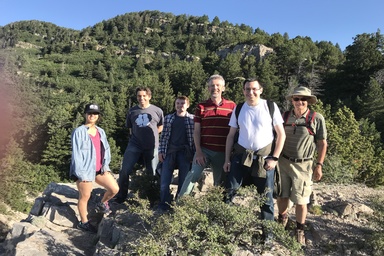LAMMPS WWW Site
LAMMPS Workshop and Symposium
August 13-15, 2019
Logistics
The sixth LAMMPS Workshop and Symposium was held in Albuquerque,
NM, at the University of New Mexico (UNM) Continuing Education
Building (1634 University Blvd NE, map).
All the PDFs we receive for talks, posters, tutorials will be posted
below, for viewing or download.
Here is the list of workshop attendees.




Click on a pic for a larger version, which can be downloaded.
The 1st place poster award was presented to Vaibhav Palkar (Clemson University).
The 2nd place poster award was presented to Felipe Perez (University of Oklahoma).
See details on these and other posters below.
Thanks to our funders
We thank the DOE/NNSA ASC program for support in hosting this
workshop. We also thank these partners for graciously providing
additional financial support:
Here is more info on the LAMMPS-related tools these
sponsors create and provide.
Invited speakers
Our workshop program included a keynote speaker and 5 invited talks:
- Keynote speaker: Vasily Bulatov (Lawrence Livermore National Lab),
bio
- Crossing Materials Scales with LAMMPS,
PDF
- Susan Rempe (Sandia National Labs), bio
- Assessing Biomolecular Hydration Mimicry for Ion Permeation through
Membrane Channels, PDF
- Niels Gronbech-Jensen (UC Davis), bio
- Acquisition of Precise Statistics in Stochastic Langevin Molecular
Dynamics
- Ray Shan (Materials Design, Inc.), bio
- High Value from High Throughput: Harness the Power of LAMMPS with
MedeA, PDF
- Alex Stukowski (Darmstadt University of Technology), bio
- OVITO 3.0: A powerful data analysis and visualization solution for
LAMMPS users, PDF
- Xiang-Guo Li (UC San Diego), bio
- Quantum-accurate Force Fields from Machine Learning of Large Materials
Data, PDF
Program
Tuesday August 13, 2019
All-day beginners tutorial
IMPORTANT: Instructions as to tutorial software you should download
and/or install on your laptop before the workshop is posted at this
tutorial site.
Note that final info may not be posted there until Fri, Aug 9. A
couple of the LAMMPS developers are working through some last-minute
glitches for this collection of software that may not be settled until
Fri.
What you can and should do now is install the Virtual Box virtual
machine software on your laptop. It can either be downloaded from
https://www.virtualbox.org/wiki/Downloads for Windows, Mac, Linux. Or
it is also available prepackaged for several popular Linux
distributions; you can install it directly via your distribution's
package manager.
Coffee and bagels will be available.
8:30-12:00 Beginners Tutorial Part I
- 8:30 Welcome and Tutorial Overview
- Axel Kohlmeyer (Temple U)
- 8:45 A Brief Overview of Molecular Dynamics, Statistical Mechanics,
Atomic Potentials
- Stan Moore (Sandia)
- 9:30 A Quick Tour of LAMMPS
- Steve Plimpton (Sandia)
-
- Input scripts and output, classes of commands, basic & more advanced
features, parallelism
- 10:15 Break
-
- 10:30 Self-Study Tutorial with Provided
Exercises
-
12:00 Pizza lunch
1:00-5:30 Beginners Tutorial Part II, with 3 optional Intermediate
Sessions
- 1:00 Continued Self-Study Tutorial with Provided Exercises or LAMMPS
Examples
-
- 2:00 Advanced System building using VMD/TopoTools and LAMMPS
- Axel Kohlmeyer (Temple U)
- 3:15 Break
-
- 3:30 Compiling LAMMPS from Source
- Richard Berger, Axel Kohlmeyer (Temple U)
- 4:00 OpenKIM Tutorial
- Ryan Elliott and Ellad Tadmor (U Minnesota)
5:00 Dinner
We will provide info and coordinate at the end of the tutorial on 2-3
nearby restaurants where we can gather and socialize for dinner. Car
pooling is encouraged.
Wednesday August 14, 2019
8:30-12:00 General Session of technical talks
Coffee and bagels will be available.
Session chair: Aidan Thompson (Sandia)
- 8:30 Steve Plimpton, (Sandia National Labs)
- "Welcome and what's new in LAMMPS", PDF
- 9:00 (keynote) Vasily Bulatov (Lawrence
Livermore National Lab)
- Crossing Materials Scales with LAMMPS,
PDF
- 9:45 (invited) Alex Stukowski (Darmstadt University of
Technology)
- OVITO 3.0: A powerful data analysis and visualization solution for
LAMMPS users, PDF
10:15 Break
- 10:30 Mitch Wood, Sandia National Labs
- Top-Down versus Bottom-Up Multiscale Modeling of Energetic
Materials, PDF
- 10:45 Remi Dingreville, Sandia National Labs
- Insights into modeling radiation damage using atomistic
simulations
- 11:00 Julien Tranchida, Sandia National Labs
- SPIN, a package for coupled spin and lattice simulations in
LAMMPS, PDF
- 11:15 Javier Rojas, Universidad de Santiago de Chile
- Modulated strength on FeNi nanowires,
PDF
- 11:30 Sungkwang Mun, Mississippi State University
- Modified Embedded Atom Method with Bond Order Implementation in
LAMMPS, PDF
- 11:45 Andrew Rohskopf, MIT
- Vibrationally Accurate Interatomic
Potentials, PDF
12:00 Box lunches from UNM catering
1:00-5:30 General Session of technical talks
Coffee and cookies will be available.
Session chair: Mitch Wood (Sandia)
- 1:00 (invited) Niels Gronbech-Jensen (UC Davis)
- Acquisition of Precise Statistics in Stochastic Langevin Molecular
Dynamics
- 1:30 Kipton Barros, Los Alamos National Lab
- Building better datasets: active learning and transfer
learning
- 1:45 Andrew Garmon, Clemson University
- Parallel Trajectory Splicing
- 2:00 Yidong Xia, Idaho National Laboratory
- Many-GPU Simulation of Nanopore Flow on the Summit
Supercomputer, PDF
- 2:15 Stan Moore, Sandia National Labs
- LAMMPS KOKKOS Package: The quest for performance portable
MD, PDF
- 2:30 Lucas Hale, NIST
- Interatomic Potentials Repository and iprPy,
PDF
- 2:45 Ellad Tadmor, University of Minnesota
- OpenKIM: A Repository of Tested Interatomic Potentials for use with
LAMMPS, PDF
- 3:00 Ryan Elliott, University of Minnesota
- A How-To Tutorial on Using OpenKIM with
LAMMPS, PDF
3:15 Break
- 3:30 Dan Bolintineanu, Sandia National Labs
- Granular simulations with LAMMPS: enhanced contact models and
applications to powder rheology,
PDF
- 3:45 Huilin Ye, University of Connecticut
- A highly efficient and portable fluid-structure simulation package
implemented in LAMMPS, PDF
- 4:00 Adrian Diaz, University of Florida
- CAC simulation with LAMMPS, PDF
- 4:15 Ketan Khare, NIST
- Quantitative Integration of Atomistic Simulation and Experiment for
Cross-linked Epoxy Network, PDF
- 4:30 Allan Avila, Aimdyn Inc.
- Modeling Hydrogen-Oxygen Combustion via Programmable
Potentials
- 4:45 Jacob Gissinger, University of Colorado
- DisARMMD: Distance-Actuated Reaction Mechanisms in Molecular
Dynamics, PDF
- 5:00 (invited) Susan Rempe (Sandia National Labs)
- Assessing Biomolecular Hydration Mimicry for Ion Permeation through
Membrane Channels, PDF
6:00 No-host dinner and tram ride to top of Sandia Mountains
We have a group reservation at the County Line
Barbecue, 9600 Tramway Blvd NE,
which is 13 miles from the UNM conf center, at the foot of the Sandia
mountains. Car pooling encouraged.
We've ordered the Cadillac family style menu (see page
2),
which includes all-you-can-eat ribs, several other BBQ meats, sides,
and homemade ice cream. Vegetarian options (e.g. kabobs) are also
available. With tax and tip it comes to $38 per person. Pricey, but
lunches are provided, and it's our one big workshop social event!
After dinner, those who wish can join us to ride the ABQ Tram ($25) to
the top of the mountain (6000 up to 10000 ft elevetion) and see the
city views and lights. Even in the summer it can be cool and windy on
top, so it's a good idea to bring a light jacket or sweater. This is
also a good test of whether you're scared of heights (1000 ft drop
across the final canyon).
Thursday August 15, 2019
Coffee and bagelswill be available.
8:30-10:30 General Session of technical talks
Session chair: Stan Moore (Sandia)
- 8:30 (invited) Ray Shan (Materials Design Inc.)
- High Value from High Throughput: Harness the Power of LAMMPS with
MedeA, PDF
- 9:00 Christoph Kloss, DCS Computing
- Marketplace - towards an online gateway to materials
modelling, PDF
- 9:15 Kosuke Ohata, JSOL Corporation
- Integrated simulation system for soft materials,
J-OCTA, PDF
- 9:30 Andrew Jewett, The Scripps Research Institute
- General Agent Based Modeling in LAMMPS,
PDF
- 9:45 Godehard Sutmann, Juelich Supercomputing Centre,
Forschungszentrum Juelich
- A Load Balancing Library for Particle Simulation
Codes, PDF
- 10:00 (invited) Xiang-Guo Li (UC San Diego)
- Quantum-accurate Force Fields from Machine Learning of Large Materials
Data, PDF
10:30 Group photo (Matt Lane)
10:35-12:00 Poster Session
Session chair: Julien Tranchida (Sandia)
 For the first time this year, we had awards for
the best posters, judged by a sophisticated machine learning algorithm
(with possible human intervention).
For the first time this year, we had awards for
the best posters, judged by a sophisticated machine learning algorithm
(with possible human intervention).
10:35 One-minute poster advertisements
11:00 Posters in lobby
NOTE: You may setup your posters anytime on Wed, so attendees can
browse them in advance.
- (1) John Clay (ERC, Inc.)
- Using LAMMPS to Model Vapor-Liquid Equilibrium
- (2) Yu-Hang Tang (Lawrence Berkeley National Lab)
- Marginalized Graph Kernel for Molecular Property
Prediction
- (3) Kenji Nishimura (National Institute of Advanced Industrial Science and
Technology)
- Molecular dynamics study on defect formation in SiC
film
- (4) Rodolfo Aguirre (University of Texas at El Paso)
- Using Molecular Dynamics to study polycrystalline interfaces and
grain boundaries in CdTe heterostructures
- (5) Chun-Yaung Lu, (Texas Advanced Computing Center, UT Austin)
- A Notebook Based Platform for Computational Materials Science and
Chemistry
- (6) Michael DeLyser (Pennsylvania State University)
- Bottom-up Open-source Coarse-graining Software
- (7) Ryan Szukalo (Penn State University)
- Investigating the State Point Dependence of Coarse-Grained Potentials
Across a Glass Transition
- (8) Dmitry Luchinsky (SGT Inc at NASA Ames Research Center)
- Atomistic model of welding at polymer interfaces for aerospace
applications
- (9) Hideyo Yoshida (JSOL Corporation)
- Creating Representative Volume Element by LAMMPS for Finite Element
Analysis
- (10) Felipe Perez (University of Oklahoma)
- Molecular signatures of enhanced oil recovery in shale organic
pores
- (11) Naida Lacevic (Materials Design, Inc.)
- Designing Atomistic Simulation Workflows with MedeA®, A Case Study:
Viscoelasticity of Glycerol at Ultra-high Frequencies
- (12) Manav Bhati (Rice University)
- Multi-scale investigation of adhesion properties of Si/polymer
interfaces using ReaxFF reactive force field
- (13) Visal Subasinghege Don (Louisiana State University)
- Computational Investigations of Structure and Dynamics at the
Interface
- (14) Vaibhav Palkar (Clemson University)
- Development of a DPD framework for simulating tetra-PEG hydrogels with
degradable crosslinks
- (15) Hyungmook Kang (UC Berkeley)
- Molecular Insight into the Lower Critical Solution Temperature
Transition of Ionic Liquids
- (16) Jan Lugowski (Purdue University)
- Turbulence: Mathematics or Physics Problem?
- (17) Kevin Hanley (University of Edinburgh)
- Multi-level contact detection to enable efficient polydisperse DEM
simulations using LAMMPS
- (18) Arjun Valiya Parambathu (Rice University)
- "Computing NMR relaxation in alknae systems using Molecular Dynamics"
- (19) Mohamed Mehana (University of Oklahoma)
- Molecular modelling of Kerogen Wettability
- (20) John Karnes, Lawrence Livermore National Lab
- Toward Photopolymer Resin Design for Additive
Manufacturing
- (21) Katsumi Hagita, National Defense Academy of Japan
- "Coarse-Grained MD Simulations of Nanovoids in Elongated Polymer
Nano-Composites"
- (22) Cameron Shock, Michigan Technological University
- "Solvation Energy of Ions in a Stockmayer Fluid"
12:00 Box lunches from UNM catering
12:55 Presentation of best poster award. This is being given in
honor of Ahmed Ismail, a former collaborator of many of us at Sandia,
and a LAMMPS contributor and user. Ahmed passed away earlier this
year.
The 2st place poster award was presented to Vaibhav Palkar (Clemson University).
The 1st place poster award was presented to Felipe Perez (University of Oklahoma).
See photos at the top of this page.
1:00-5:30 Breakout Sessions (two parallel tracks A and B)
Coffee and cookies will be available.
Session chair: Aidan Thompson (Sandia)
1:00-1:15: One-minute breakout advertisements
Track A
1:15-2:15 Pre- and post-processing tools & visualization (tutorial)
Chaired by Mitch Wood (Sandia)
- Alex Stukowski (Darmstadt University of Technology)
- This presentation will demonstrate how to use OVITO with LAMMPS.
- Andrew Jewett (The Scripps Research Institute)
- Creating molecular assemblies and force fields with
Moltemplate
-
- This presentation will demonstrate how to use Moltemplate, PACKMOL, and
VIPSTER (time permitting).
2:15-3:15 Adding features to LAMMPS (tutorial)
Presented by Richard Berger (Temple U) and Axel Kohlmeyer (Temple U)
Topics: code structure, git, Github, best practices
3:15 Break
3:30-4:30 Machine-learned interatomic potentials (contributed)
Session chair: Thomas O'Connor (Sandia)
- 3:30 Ying Li, University of Connecticut
- Machine learning force field for polymer modeling
- 3:45 Chun-Wei Pao, Research Center for Applied Sciences, Academia
Sinica, Taiwan
- Neural Network Potential of Complex Perovskite Materials and Their
Implementation to LAMMPS, PDF
- 4:00 James Hickman, NIST
- Development of physically informed neural network (PINN) interatomic
potentials, PDF
- 4:15 Mary Alice Cusentino, Sandia National Labs
- Machine Learned Interatomic Potentials for Modeling Plasma Material
Interactions, PDF
4:30-5:30 Solid-state and soft materials (contributed)
Chaired by Amalie Frischknecht (Sandia)
- 4:30 Tuan Ho, Sandia National Labs
- Molecular Simulation of the Multicomponent Interaction in Shale
Nanopores
- 4:45 Rafael Gonzalez, Center for Applied Nanotechnology, Universidad Mayor
- Molecular simulations of carbon allotropes in processes with creation
and destruction of chemical bonds,
PDF
- 5:00 Omar Almahmoud, University of North Texas
- Water vapor diffusion in polyurethane silica
nano-composite
- 5:15 Samuel Baltazar, Universidad de Santiago de Chile
- Nanostructurated systems for water remediation
process, PDF
Track B
1:15-2:15 VOTCA and LAMMPS for electronic spectroscopy and
transport: Part I (tutorial)
Chaired by Christoph Junghans (LANL)
In this breakout (and the following one) you will learn how to use
VOTCA to simulate electron/hole/exciton transport and compute optical
spectra for organic molecules using LAMMPS trajectories.
The 2 hours will start with a 25 min introduction and explanation of
the theory and the implementation in VOTCA. This is followed by a
hands-on session.
If you want to participate in the hands-on session, please have docker
installed on your laptop:
2:15-3:15 VOTCA and LAMMPS for electronic spectroscopy and transport:
Part II (tutorial)
Chaired by Christoph Junghans (LANL)
See the previous breakout for description.
3:15 Break
3:30-4:30 Coarse grained systems (atomistic, meso, continuum) (contributed)
Chaired by Dan Bolintineanu (Sandia)
- 3:30 Yu-Hang Tang, Lawrence Berkeley National Lab
- Marginalized Graph Kernel for Molecular Property
Prediction
- 3:45 David Rosenberger, Los Alamos National Laboratory
- Coarse grained molecular dynamics simulations in the
isothermal,isobaric ensemble,
PDF
- 4:00 Ishan Srivastava, Sandia National Labs
- Discrete Element Simulations of Li-ion Electrodes using Brownian and
Granular Dynamics
- 4:15 Christoph Kloss, DCS Computing
- "Modelling of flow of viscoelastic materials with DEM and CFD"
4:30-5:30 Simulation setup via EMC (tutorial)
Presented by Pieter in 't Veld (BASF)
6:00 No-host dinner
Plans for this are TBD, since we don't yet know how many people are
sticking around after the workshop ends. We'll likely head to ABQ's
Old Town area where there are several good restaurants and some site
seeing we can do.
And for those still here on Fri AM, Aidan is talking about
organizing a group hike.
Associated Software Tools and Projects
These are products from sponsors or tools that will be discussed
during breakouts and tutorials:
 For the first time this year, we had awards for
the best posters, judged by a sophisticated machine learning algorithm
(with possible human intervention).
For the first time this year, we had awards for
the best posters, judged by a sophisticated machine learning algorithm
(with possible human intervention).




 For the first time this year, we had awards for
the best posters, judged by a sophisticated machine learning algorithm
(with possible human intervention).
For the first time this year, we had awards for
the best posters, judged by a sophisticated machine learning algorithm
(with possible human intervention).